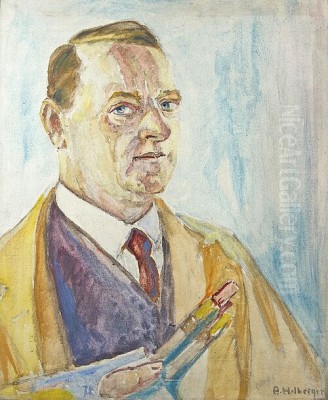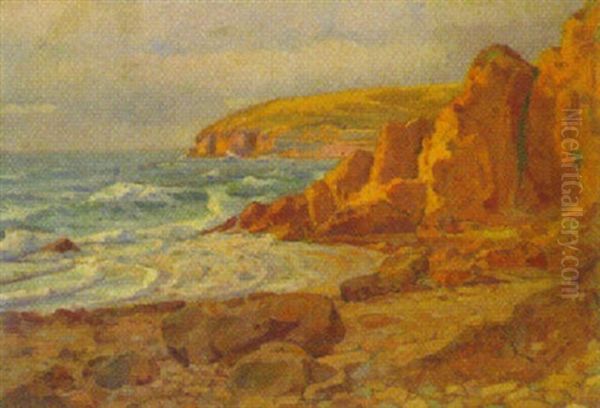
Alfred Hermann Helberger stands as a notable, albeit tragically curtailed, figure in early 20th-century German art. A painter of landscapes and portraits, his career navigated the vibrant currents of Impressionism and the bold assertions of Fauvism, only to be brutally interrupted by the oppressive cultural policies of the Nazi regime. His life, marked by artistic exploration and profound personal suffering, offers a poignant lens through which to view the creative spirit in an era of immense upheaval.
Early Life and Artistic Beginnings
Born on May 23, 1871, in Frankfurt am Main, Germany, Alfred Hermann Helberger was destined to immerse himself in the world of art. The late 19th century in Germany was a period of significant artistic ferment, with traditional academic styles gradually giving way to more modern, individualistic approaches. By 1894, Helberger had made a decisive move to Berlin, a city rapidly establishing itself as a major cultural and artistic hub in Europe.
In Berlin, Helberger set up his studio on Kurfürstenstraße, a location that would have placed him amidst a bustling artistic community. This period was crucial for his development, allowing him to absorb the influences of the Berlin Secession, a movement founded in 1898 by artists like Max Liebermann, Lovis Corinth, and Walter Leistikow, who sought to break away from the conservative, state-sponsored art institutions. While Helberger's direct affiliation with the Secession's core group is not extensively documented, the spirit of artistic independence and the embrace of modern styles like Impressionism were pervasive in the city's avant-garde circles.
Artistic Development and Influences
Helberger's artistic inclinations led him primarily towards landscape and portrait painting. His early work shows a clear affinity with Impressionism, a style that had originated in France with artists such as Claude Monet, Pierre-Auguste Renoir, and Camille Pissarro, and which emphasized capturing the fleeting effects of light and atmosphere, often through en plein air (outdoor) painting. German artists, including the aforementioned Liebermann, Corinth, and Max Slevogt, developed their own distinct version of Impressionism, and Helberger's work can be seen within this broader German Impressionist context.

To deepen his understanding and refine his technique, Helberger undertook several study trips. He traveled to the Netherlands, a country whose landscapes, light, and artistic heritage (particularly the Dutch Golden Age painters) had long fascinated artists. These trips would have provided him with rich subject matter, from canals and windmills to coastal scenes, allowing him to explore the nuanced interplay of light and water. He also journeyed to Norway, whose dramatic fjords and unique northern light offered a different palette and compositional challenge, likely inspiring a more rugged and perhaps moodier element in his landscapes.
A significant journey in 1905 took him to the United States of America. While the specifics of his American sojourn are not widely detailed, this experience would have exposed him to a different cultural landscape and potentially new artistic currents. Later in his career, Helberger's style evolved, showing the influence of Fauvism. This movement, spearheaded by artists like Henri Matisse and André Derain in France around 1905, was characterized by its use of strong, non-naturalistic colors and fierce brushwork to convey emotional intensity rather than objective reality. This shift suggests Helberger was an artist open to experimentation and keen to engage with the latest developments in European art.
Notable Works and Artistic Themes
Among Helberger's representative works, Bedhende Bäume (often translated as "Bathing Trees" or "Praying Trees") from 1931, an oil on canvas measuring 57 x 71 cm, exemplifies his landscape painting. The title itself suggests a poetic, perhaps anthropomorphic, view of nature. One can imagine a scene where trees are depicted with a sensitivity to light and atmosphere, possibly near water, reflecting his Impressionistic roots, or perhaps with the bolder coloration indicative of his later Fauvist leanings.
Another significant piece is Bornholmer Küste ("Bornholm Coast"), dated to 1909 (though some sources suggest 1919, with an auction in 1922). This work, measuring 89 x 70 cm, would depict the coastline of the Danish island of Bornholm in the Baltic Sea. Known for its picturesque scenery and unique light, Bornholm was a popular destination for artists. This painting likely showcases his skill in capturing maritime landscapes, the texture of cliffs, the movement of the sea, and the specific atmospheric conditions of the Baltic region. His focus on Dutch and Scandinavian landscapes, as well as coastal scenes, indicates a profound connection to nature and a keen eye for the particularities of different environments.
Connections and Contemporaries
Alfred Hermann Helberger was not an isolated figure. He was part of the Nidda artists' group (Niddaer Künstlerkolonie). Artist colonies were common in Europe at the time, providing spaces for artists to live, work, and exchange ideas away from the pressures of urban centers. Within this group, he associated with figures such as Hans Beppo Borschke and Bertha Schütz. These interactions, often taking place at informal gatherings like those at Blode's artist studio or on its terrace, would have fostered a supportive and intellectually stimulating environment.
In Berlin, his connections extended to other prominent painters, including Hans Herrmann, known for his atmospheric cityscapes and Dutch scenes, and Philipp Ludwig Herrmann. He also held a joint exhibition with the artist Emil Bizer in Berlin during February and March of 1922. Such collaborations and exhibitions were vital for artists to gain visibility and engage in dialogue with their peers and the public. His artistic milieu would have also included awareness of, if not direct contact with, other leading German artists of the time, such as the Expressionists who were gaining prominence, like Ernst Ludwig Kirchner, Emil Nolde, and Franz Marc, members of groups like Die Brücke and Der Blaue Reiter.
The Shadow of Nazism: "Degenerate Art"
The rise of the Nazi Party to power in 1933 marked a catastrophic turning point for modern art in Germany, and for Alfred Hermann Helberger personally. The Nazi regime, under Adolf Hitler, espoused a narrow, reactionary view of art, promoting a heroic, realistic style that aligned with their ideology. Modern art movements, including Impressionism (especially its later forms), Fauvism, Expressionism, Cubism, Dada, and Surrealism, were condemned as "degenerate" (Entartete Kunst).
These styles were deemed un-German, Jewish, Bolshevik, or simply incomprehensible and therefore corrupting to public morals and taste. Artists producing such work faced persecution: they were dismissed from teaching positions, forbidden to exhibit or sell their art, and in many cases, their works were confiscated from museums and public collections. Famous exhibitions of "Degenerate Art" were organized by the Nazis, such as the one in Munich in 1937, intended to mock and vilify modern artists and their creations.
In 1937, Alfred Hermann Helberger's work fell victim to this brutal cultural purge. His art was officially labeled "degenerate," and he was banned from exhibiting. This prohibition would have been a devastating blow, effectively ending his public career and cutting him off from his livelihood and artistic community. For an artist whose life was dedicated to creation and expression, such a ban was not just a professional setback but a profound personal and existential crisis. He joined the ranks of many other esteemed artists whose careers were shattered by the Nazi regime, including Käthe Kollwitz, Otto Dix, George Grosz, and Paul Klee, among countless others.
Final Years and Tragic Demise
The years following the exhibition ban were undoubtedly filled with hardship and despair for Helberger. The artistic environment in Berlin, once vibrant and progressive, had become stifling and dangerous for those who did not conform to Nazi aesthetics. The outbreak of World War II in 1939 only intensified the suffering and persecution.
The final, tragic chapter of Helberger's life unfolded against the backdrop of the Holocaust and the war's devastating impact on Germany. His wife, whose name is not widely recorded in easily accessible sources, was Jewish or considered Jewish by the Nazis. She was eventually arrested and deported to a concentration camp – a fate shared by millions. The specific camp to which she was sent is not clearly documented in the available information.
Overwhelmed by this personal tragedy, the loss of his wife, the destruction of his career, and the oppressive atmosphere of Nazi Germany, Alfred Hermann Helberger saw no way out. In 1945, shortly after his wife's deportation, he made the devastating decision to take his own life. Some sources state his death occurred on January 31, 1946, in Berlin, as the war had concluded but its aftermath continued to bring suffering. This act of despair underscores the profound human cost of the Nazi regime's tyranny, extending far beyond the battlefields to crush the spirits and lives of individuals like Helberger.
Legacy and Posthumous Recognition
Despite the tragic end to his life and career, Alfred Hermann Helberger's work has not been entirely forgotten. His paintings continue to be held in private collections and occasionally appear in art markets, particularly in Scandinavia, the Netherlands, and Germany – regions he was connected to through his travels and artistic focus. The enduring appeal of his landscapes and portraits speaks to his skill as a painter and his ability to capture the essence of his subjects with sensitivity and a nuanced understanding of light and color.
He is buried in the Heerstraßfriedhof, a cemetery in the Charlottenburg-Wilmersdorf district of Berlin. His grave serves as a quiet reminder of a life dedicated to art, tragically cut short by historical forces.
Information about Helberger can be found in various art historical resources, including the Allgemeines Künstler-Lexikon, and archival records such as those in the Landesarchiv Berlin (reference A. Rep. 243-045). German Wikipedia also provides a summary of his life and work, helping to keep his memory alive for a contemporary audience. Auction catalogues and art magazines like Kunst und Antiquitäten have also featured his works, providing details on specific pieces and their provenance.
Alfred Hermann Helberger's story is a poignant reminder of the fragility of artistic freedom and the devastating impact of totalitarian regimes on cultural life. His journey from the promising art scenes of Frankfurt and Berlin, through the exploration of Impressionist and Fauvist aesthetics, to the persecution under Nazism and his eventual tragic death, encapsulates a dark chapter in European history. Yet, through the surviving artworks, his artistic voice, though silenced prematurely, continues to resonate, offering glimpses of a talent that deserved to flourish. His legacy, like that of many artists of his generation, is intertwined with the imperative to remember and to champion the freedom of artistic expression against all forms of oppression.